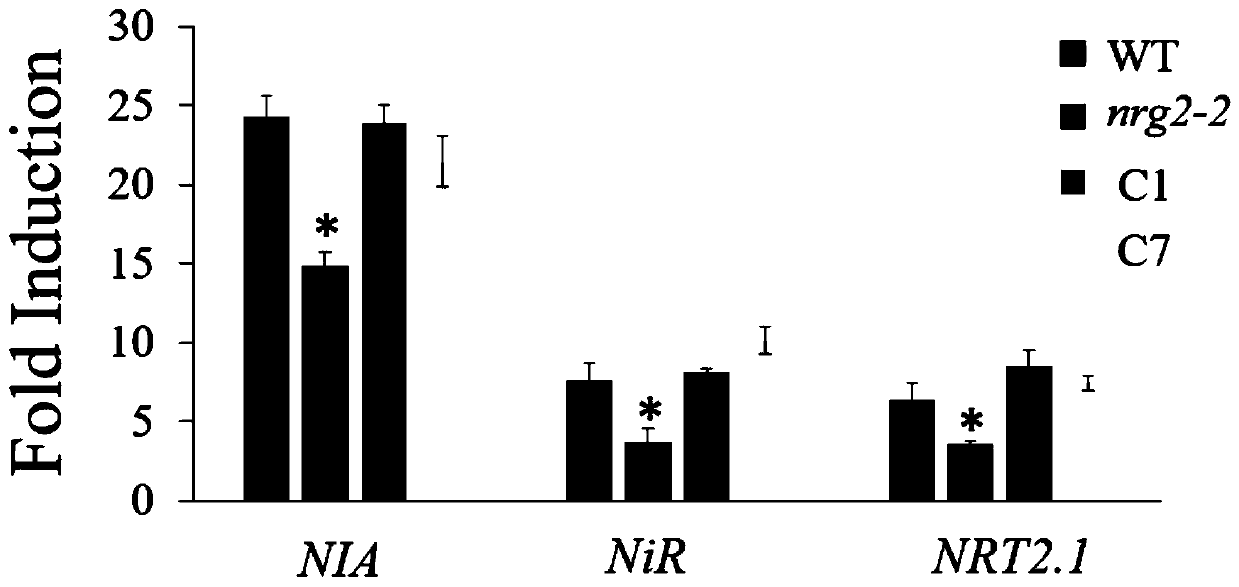Nitrate nitrogen regulating and control gene ZmNRG2.7 from corn and purpose thereof
A technology for regulating genes, zmnrg2.7, applied in genetic engineering, plant gene improvement, application, etc., can solve problems such as corn research that has not been reported, and achieve the effect of improving nitrogen use efficiency
- Summary
- Abstract
- Description
- Claims
- Application Information
AI Technical Summary
Problems solved by technology
Method used
Image
Examples
Embodiment 1
[0058] Embodiment 1: Fluorescence complementation experiment
[0059] Fluorescence complementation experiment is an important means to identify whether a gene is a nitrate-nitrogen-regulated gene. In order to determine whether ZmNRG2.7 is a nitrate-nitrogen-regulated gene, the present invention screens out a homozygous transgenic line of ZmNRG2.7 / nrg2-3, Among them, nrg2-3 is the mutant obtained by EMS mutagenesis screening, in 5mM KNO 3 Grow on solid medium for 5 days and observe the fluorescence ( figure 1 ).
[0060] Due to the mutation of the AtNRG2 gene, the fluorescence of yellow fluorescent protein induced by the nitrate nitrogen signal in the body was significantly reduced, so nrg2-3 showed a weak fluorescence phenotype. When we transformed the ZmNRG2.7 gene into nrg2-3, the fluorescence of yellow fluorescent protein induced by the nitrate nitrogen signal in its transformed homozygous lines returned to the wild-type level of the system ( figure 1 ), indicating that ...
Embodiment 2
[0063] Embodiment 2: Construction of ZmNRG2.7 plant expression vector
[0064] The wild-type B73 maize seedlings normally grown to the three-leaf stage were grown on 1 / 2 MS medium for 7 days, and the whole seedlings were taken and genomic DNA was extracted. Using the extracted DNA as a template, high-fidelity DNA polymerase was used to amplify the gene fragment of ZmNRG2.7, and the primer sequences used in PCR were:
[0065] Upstream primer: 5'-TTTACTAGTATGGGTTGCTCCAACTCTAAAGT-3', the nucleotide sequence of which is shown in SEQ ID NO.3;
[0066] Downstream primer: 5'-TTTGGTACCCGAGGAAATAGCAGGTGAAGCT-3', the nucleotide sequence of which is shown in SEQ ID NO.4. The PCR product was electrophoresed in 1% agarose, and the target band was found according to the DNA Marker and the gel block was excised. Utilize the gel recovery kit (purchased from Omega Company) to recover the target DNA, carry out enzyme digestion (SpeI and KpnI) to the recovered target DNA and plant expression v...
Embodiment 3
[0072] Embodiment 3: Identification of transgenic positive plants
[0073] Pick the Agrobacterium cells stored at -80°C in 250mL LB culture medium, place them on a shaker at 28°C, and culture them with shaking for 16 hours. Agrobacterium was used to infect Arabidopsis wild-type plants by flower dipping method. After the plants are mature, collect the seeds, and spread the seeds in the water containing H + On the resistant 1 / 2 MS plate, the screened positive seedlings are the transgenic line T1 generation. The selected T1 generation seeds were transplanted into vermiculite for cultivation, and the T2 generation seeds were harvested. The T2 generation seeds in the H + The resistant 1 / 2 MS plate was cultured, and its survival rate was found to be 3 / 4. The surviving T2 plants were moved to vermiculite for culture, and the T3 generation seeds were harvested from a single plant. Seeds of the T3 generation in the H + The resistant 1 / 2 MS plates were cultured, and the homozygous ...
PUM
 Login to View More
Login to View More Abstract
Description
Claims
Application Information
 Login to View More
Login to View More - R&D
- Intellectual Property
- Life Sciences
- Materials
- Tech Scout
- Unparalleled Data Quality
- Higher Quality Content
- 60% Fewer Hallucinations
Browse by: Latest US Patents, China's latest patents, Technical Efficacy Thesaurus, Application Domain, Technology Topic, Popular Technical Reports.
© 2025 PatSnap. All rights reserved.Legal|Privacy policy|Modern Slavery Act Transparency Statement|Sitemap|About US| Contact US: help@patsnap.com



